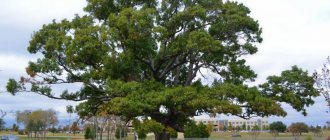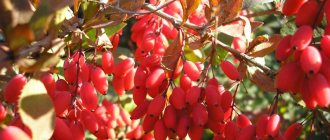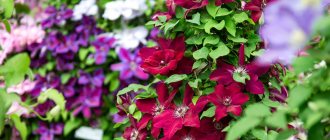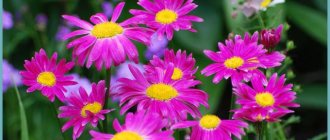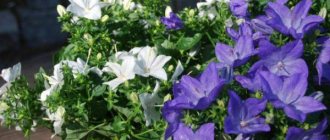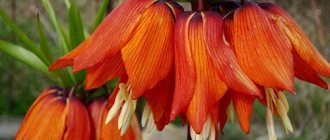Flowering vines are a favorite plant among designers, used to decorate the landscape. Even apartment residents fell in love with Clematis Multi Blue, which is fascinating with its lush forms of flowers because of the opportunity to grow the plant on the balcony. The decorative bushy variety belongs to the Patens group. The plant is compact. The shoots of the vine grow to a maximum length of 2 m. Young vines are quite flexible, but very fragile. This must be taken into account when laying vines on the trellis by hand. The shoots gain strength towards the end of the season.
Considering clematis Multi Blue, photo and description, let’s first get acquainted with the characteristics of the variety:
- In many clematis, the root system goes deep. A feature of the variety is the superficial location of the roots. Moreover, they are so shallowly buried that it is impossible to loosen the soil around the bush with a hoe. Damage to the roots threatens the rapid death of the vine. They can get rid of crust formation on the soil after watering only by mulching.
- The growing season for clematis variety Multi Blue begins early. The kidneys awaken with the first warmth. Liana quickly sprouts shoots. The leaves grow narrow, elongated with a sharp tip. Leaf length is about 10 cm.
- Clematis Multi Blue Multi Blue blooms throughout the warm season. During the growing season, new buds are constantly being laid on the vine. The flower is double, blue with a predominant violet tint. The lush center is formed from graceful pink stamens. Occasionally they turn red. The flower reaches 18 cm in diameter. Pubescence forms on the back side of the petals.
According to its intended purpose, clematis grandiflora Multi Blue blue terry is recommended for growing outdoors. However, enterprising gardeners have learned to plant vines on the balcony. The plant only needs a large barrel of soil.
Attention! Growing clematis indoors is allowed if the balcony is designed for heavy loads. This is due to the massiveness of the container with earth.
The video shows clematis variety Multi Blue:
Description of clematis Multi Blue
Clematis of this variety belongs to liana-like plants, the shoots of which become woody over time. Its green shoots grow up to 2-2.5 m during the season. The shoots of the first year are thin and flexible, but at the same time quite fragile. This must be taken into account when tying vines to supports. As they grow, the shoots become denser and take on a brown color, while remaining flexible.
With the onset of heat, leaves immediately appear, which take on an elongated shape with a pointed tip. The foliage color is dark green. The leaves are large, up to 10 cm in length, matte, petiolate.
Bright blue flowers with a purple tint are formed on shoots that grew last and this year. Clematis Multi Blue belongs to the Patens group. These varieties always have double or semi-double flowers. Multi Blue has many petals, they are arranged in two circles. The outer ones have a rounded-oblong shape, veins and pointed tips. The petals are flat, slightly pubescent on the underside. Their number can be variable, from 6 to 8 pieces.
The inner circle of the flower has several rows of petals. They differ from the first ones in shape and size, which emphasizes the splendor and originality of this variety. Short petals, shaped like lancets or needles, are arranged vertically upward. Most often the central petals are a soft blue, but some variations from white to soft pink are possible.
In the center are the stamens, colored in various tones of light green, yellow, or white, depending on the stage of formation and opening of the bud. A flowering bush of the hybrid clematis variety Multi Blue is shown in the photo.
Interesting fact!
Multi Blue is considered a hybrid clematis. For this reason, the flower of the vine is quite large - up to 18-20 cm in diameter.
The flowering period of clematis Multi Blue begins quite early. In the first half of May, the first buds form and bloom on clematis bushes. After the first period of flowering, when the shoots of the current year grow, the second stage of violent flowering begins. In the absence of negative temperatures, it can last from May to September, giving flower growers the opportunity to enjoy this beauty every day.
The root system of Clematis Multi Blue is located close to the soil surface, which is very different from other varieties. The shrub forms many small, rather thin roots. Therefore, when growing clematis Multi Blue, you should not loosen the soil under the bushes so as not to destroy the plant. Instead of loosening, you can only mulch the soil.
Information about the frost resistance of clematis Multi Blue is contradictory. Some sources claim high resistance to low temperatures. Others characterize it as a shrub with low frost resistance. The hybrid is resistant to frosts down to –15˚С, but may not tolerate prolonged frosts. However, according to reviews from flower growers, the clematis variety Multi Blue successfully survives short-term temperature drops of –30˚–34˚С.
Features of the vine
Before moving on to the description of clematis Multi Blue, you first need to learn about its features:
- The buds of this plant awaken with the onset of the first heat. Soon after this, the vine begins to develop shoots that are actively growing.
- Many varieties of clematis have rhizomes growing deep in the ground. But Multi Blue has a superficial root system . Due to the fact that the rhizome is close to the surface, loosening the soil near the plant will lead to damage to the roots, and, consequently, to the death of the vine in the future. The only way to prevent the formation of a crust on the soil after moistening is by mulching.
- The variety is characterized by compactness, so it is grown on loggias or balconies (however, they must be able to withstand a lot of weight, since a barrel of soil for a vine has a huge weight ).
Reproduction methods
Clematis Multi Blue can be propagated in several ways:
- seeds. It is advisable to purchase seed material in specialized stores. Growing a hybrid from self-harvested seeds is extremely undesirable, since it is unknown what will grow in the end.
- dividing the bush. You can dig up a large, healthy clematis bush and divide it into several parts. But you can do without digging. On one side, carefully dig up the root system and carefully separate part of the bush. The separated part must be planted in accordance with generally accepted rules.
- cuttings The most popular, affordable and effective way to propagate Multi Blue clematis. You need to cut several cuttings with 2-3 internodes. The lower part of the cuttings is treated with root and planted in previously prepared boxes with soil for rooting.
- layering. To do this, in the spring the shoot is placed in a groove 5-7 cm deep, dug in advance in the direction “from the bush”, pinned and covered with soil. As they take root, small shoots appear that must be carefully separated and planted in a permanent place.
If you want to decorate your plot with large-flowered clematis, then the Multi Blue variety is perfect for this purpose.
Use in landscape design
Multi Blue is suitable for decorating parks, alleys, and flower beds. It looks aesthetically pleasing due to its short stature, but at the same time it can be adjacent to other plants: roses, peonies, daisies, rosehip bushes. This combination is suitable for decorating a flower bed or a composition of fresh flowers.
But most often vines are used to decorate hedges or zoning space. In this way you can decorate a gazebo or create a living partition in a restaurant. This requires high-quality support. It can be in the shape of an arch, fan or pyramid. But you can build an original frame to your liking.
Representatives of Multi Blue are graceful and short plants. It is also better to choose a non-bulky support: a mesh or lattice, bamboo frames. It must be securely fastened, taking into account the fact that the weight of the plant increases over time. It is best if it is mounted into a prepared base of concrete or brick. You should also consider whether the support itself will be part of the composition.
If it becomes completely covered with leaves, you can choose cheap plastic models. If part of the support is visible, it is better to give preference to more expensive models made of bamboo or metal. Trees, branches, and pieces of furniture can also serve as support.
It is advisable to plant the plant near the finished structure. Otherwise, the sharp edges of the lattice or mesh may damage the roots. You immediately need to monitor the growth dynamics of clematis. Young branches should be directed to the desired part of the support, making sure that the whole composition looks harmonious.
Thus, the Multi Blue variety is an excellent solution for design ideas in the garden. It looks aesthetically pleasing, elegant, and blooms for a long time. The shape of the plant allows you to solve both aesthetic and practical problems: zoning space, hiding surface imperfections. At the same time, Multi Blue is suitable for growing in temperate climates. Even an amateur gardener will be able to enjoy its view in his summer cottage.
Rules for planting and care
Planting clematis Multi Blue and subsequently caring for it is not difficult. The variety is best planted in spring or summer. In this case, the confidence that clematis will take root is much higher.
If you decide to buy Multi Blue clematis seedlings, we recommend choosing two-year-old cuttings with a well-developed root system. The minimum length of shoots is 15-18 cm. When purchasing planting material with an open root system, you need to carefully examine the roots. Plants with rotten, damaged, or signs of root system diseases should not be purchased.
Choose a sunny place for planting clematis Multi Blue. But light partial shade is also acceptable. The soil in the selected area should be loose and fertile. You should not plant clematis where there are frequent drafts.
Also, those places where melt or rainwater often stagnate are not suitable as a flower bed. Otherwise, the roots will constantly rot and hurt. Drafts are also undesirable for this variety. In most cases, flowers in such places simply die.
It is not advisable to plant clematis next to solid fences or the wall of a house (barn, garage). Firstly, moisture often accumulates in such places. And secondly, in hot weather, metal fences become very hot and can scorch the foliage and flowers of clematis.
The process of planting clematis Multi Blue is as follows:
- Planting holes should be 60x60x50 cm in size.
- First, a small layer of broken brick, crushed stone, and expanded clay is laid out.
- A mound of fertile soil mixed with compost and superphosphate is poured onto the drainage.
- The cutting is placed in a hole, trying to carefully position the root system on the prepared mound.
- Cover the Multi Blue seedling with soil, leaving 8-10 cm to the edge. This small depression can be leveled with the ground after 2-3 weeks, when the results of rooting will be visible.
Immediately after planting, it is necessary to water and treat the clematis bush with copper sulfate or other fungicides to prevent fungal diseases.
Flower care
This variety is unpretentious. The complex of measures for caring for clematis Multi Blue includes:
- watering;
- feeding;
- mulching;
- pruning;
- preparation for winter.
Water clematis 1-2 times a week depending on weather conditions. During drought, the frequency and volume of watering is increased. But during periods of frequent rains, watering must be abandoned. To prevent moisture evaporation, the soil under the bushes is mulched.
Attention!
It is not recommended to loosen the soil in the area where Multi Blue clematis grows.
Clematis of this variety does not like frequent feeding. During the period of active shoot growth, the plant is fed with nitrogen fertilizer. In the fall, it is useful to fertilize the plant with phosphorus-potassium fertilizer. It will help strengthen the root system before the onset of a harsh winter.
You can prepare organic fertilizer for clematis Multi Blue yourself. Weeds are placed in a barrel of water and some manure is added. The mixture should ferment for several weeks. It is then used as fertilizer.
It is imperative to mulch the soil around clematis. This will not only help contain moisture evaporation, but also protect the plant’s roots from overheating. In addition, there are significantly fewer weeds in mulched areas.
Flowers of clematis variety Multi Blue (see photo) are formed on new and last year's shoots, so in the fall the vine is pruned, leaving their height to 1-1.2 m. In the spring, with the onset of warm weather, bright green leaves quickly bloom and the first bright blue buds. When the first wave of flowering ends, it is necessary to trim the old shoots to a height of 20-30 cm. At this time, the first buds should already form on fresh stems, which indicate the second wave of flowering.
To prevent moisture from accumulating in the center of tillering and near the root system during the winter and spring periods, the shrub must be prepared for wintering. Clematis bushes are mulched. In this case, it is advisable not to skimp on material and pour a thicker layer of mulch (at least 15-18 cm), and lay spruce branches on it. The shoots are carefully rolled into a ring and placed on the branches. A layer of coniferous branches is applied again, and then covered with non-woven material. You can cover the plant with lutrasil on top and press the edges so that it does not blow away with the wind.
In spring, you should not immediately open clematis bushes. Mulch and covering material are removed gradually, layer by layer. Only when the threat of frost has passed can the bushes be completely freed.
On a note!
Covered clematis Multi Blue tolerates winter well, but in the spring it can be supported by the shelter. Therefore, you should not keep the flowers under cover for too long.
Planting in open ground
Planting clematis in open ground should be carried out according to certain rules. Violation leads to the fact that the plant becomes very sick and for a long time cannot please with vigorous flowering. If everything is done correctly at the time of planting the seedling in open ground, then there will be no difficulties with growing the vine. The main thing is to give it time to get stronger.
How and when to plant?
The plant should be planted in the spring, before its buds are very swollen. Planting clematis with leaves is highly undesirable, but possible. In autumn, it is also permissible to plant vines, but this period is used only in the southern regions, since there is a high risk that the flower will not have time to take root and will freeze in winter.
- The plant is planted in a hole 60x60x50 cm. At its bottom, a drainage layer of broken bricks and expanded clay is provided. After this, an earthen mound is formed on which the plant is installed. Its roots are evenly distributed over the mound.
- The root collar is buried 8 cm. This, when the soil subsides, will prevent exposure of the roots, which, if not immediately noticed, will easily lead to the death of the plant.
- The soil around the clematis must be compacted, after which it is watered very generously.
Soil and site preparation
The area where clematis will grow is weeded at a distance of at least 1 meter from the hole prepared for the vine. This is necessary so that weeds do not choke the plant. The location is chosen precisely so as not to subject the plant to repeated stress during additional replanting.
- The soil for the mound is taken from the soil that remains after digging the hole, but enriched with humus, wood ash and manure. The first and third components are needed in the amount of ½ bucket, and the second - in the amount of 2 handfuls. If the soil is particularly poor, then complex mineral fertilizer is also applied (strictly according to the instructions).
Landing nuances
It is necessary to plant clematis in a sunny and not windy place, where it will not be exposed to water flowing from the roof. At noon, the area where clematis grows should be in the shade, as this will ensure long-term preservation of the attractive appearance of the flowers. If they are exposed to the sun all day, they will begin to fade.
Diseases and pests
The clematis variety Multi Blue is quite resistant to viral diseases, but fungal infections can affect the shrub. However, if you properly care for the plant, it will not be afraid of any diseases.
Clematis Multi Blue does not like stagnant moisture or frequent rainy weather. Sometimes in the middle of summer the bush begins to fade. To prevent this from happening, the lower parts of the shoots are sprinkled with wood ash after rains.
Sometimes clematis bushes can be favored by the following pests:
- spider mites;
- nematodes.
The nematode affects the root system. Young shrubs are especially sensitive and unstable to this pest. Mature plants are more resistant to nematodes. To prevent pests from annoying, the vine is treated with insecticides for preventive purposes.
As you can see, there is no special hassle in planting and caring for Multi Blue clematis.
Appearance of the plant
Most clematis belong to the group of vines, Multi Blue is no exception. It is a climbing plant about 2 m in height with large double flowers. The shoots are thin and flexible, they can easily be attached to any support. The root system is shallow, so the plant does not tolerate low temperatures.
It is difficult for him in the harsh winter conditions. But due to its flexible branches and compact size, Multi Blue can be easily grown in containers, on balconies, terraces, and in greenhouses. A greenhouse or winter garden can be used to grow seedlings. And in the spring, plant the shoots in the ground and decorate the yard or garden plot.
- ErnstErnst: “I threw Malakhov to hell after the broadcast about “sore joints”! He dared...
>>
The flowers of this variety look bright. The color range varies from purple to pale blue. The petals are regular in shape, sharp on top. At the peak of flowering, the buds open and become almost flat. If you look closely, you can see a fluffy center with many stamens. Flowers can be cut without harming the plant.
Reviews of clematis Multi Blue
Elena, 50 years old, Kursk Multi Blue has been growing in my dacha for many years. I really like this variety. It is unpretentious and grows very quickly. I really love its large blue flowers. I don’t water clematis often, but a lot. It grows near a wooden fence, which serves as its support.
Oksana, 55 years old, Moscow region I like this variety of clematis for its unpretentiousness. You don't even need to loosen the soil. It’s better to mulch and that’s it. It blooms very long and beautifully. True, you need to trim and cover for the winter. But for such beauty you don’t regret either money or your strength.
Reviews
Olga, 55 years old, Kostroma
Multi Blue grew in our garden plot for several years. He has very beautiful flowers, the envy of all his neighbors. But last year the bush began to wither. There were no traces of fungal diseases on the leaves, so before sheltering for the winter we decided to check its roots. It turned out that our pet was attacked by a nematode; all the roots were in specific nodules. It's a shame, but the plant had to be destroyed.
Oksana, 45 years old, Uglich
Clematis are my passion. They are not only incredibly beautiful, but also unpretentious and grow very quickly. And this blue variety is just a find! The double flowers turned out even more beautiful than they were in the picture. And how many flowers are formed on each bush! During the flowering period it is just a waterfall. I water them infrequently - about once a week, when I go to the country. I use a regular wooden fence as a support for the flowers.
Maria, 60 years old, Moscow region.
My advice to those who planted “Multi Blue” is to carefully loosen the soil, or better yet, just mulch it when planting. The roots of this clematis are located very close to the surface and can be damaged.
Planting in open ground
Planting clematis in open ground should be carried out according to certain rules. Violation leads to the fact that the plant becomes very sick and for a long time cannot please with vigorous flowering. If everything is done correctly at the time of planting the seedling in open ground, then there will be no difficulties with growing the vine. The main thing is to give it time to get stronger.
How and when to plant?
The plant should be planted in the spring, before its buds are very swollen. Planting clematis with leaves is highly undesirable, but possible. In autumn, it is also permissible to plant vines, but this period is used only in the southern regions, since there is a high risk that the flower will not have time to take root and will freeze in winter.
- The plant is planted in a hole 60x60x50 cm. At its bottom, a drainage layer of broken bricks and expanded clay is provided. After this, an earthen mound is formed on which the plant is installed. Its roots are evenly distributed over the mound.
- The root collar is buried 8 cm. This, when the soil subsides, will prevent exposure of the roots, which, if not immediately noticed, will easily lead to the death of the plant.
- The soil around the clematis must be compacted, after which it is watered very generously.
Soil and site preparation
The area where clematis will grow is weeded at a distance of at least 1 meter from the hole prepared for the vine. This is necessary so that weeds do not choke the plant. The location is chosen precisely so as not to subject the plant to repeated stress during additional replanting.
- The soil for the mound is taken from the soil that remains after digging the hole, but enriched with humus, wood ash and manure. The first and third components are needed in the amount of ½ bucket, and the second - in the amount of 2 handfuls. If the soil is particularly poor, then complex mineral fertilizer is also applied (strictly according to the instructions).
Landing nuances
It is necessary to plant clematis in a sunny and not windy place, where it will not be exposed to water flowing from the roof. At noon, the area where clematis grows should be in the shade, as this will ensure long-term preservation of the attractive appearance of the flowers. If they are exposed to the sun all day, they will begin to fade.
And a little about secrets...
The story of one of our readers, Irina Volodina:
I was especially distressed by my eyes, which were surrounded by large wrinkles, plus dark circles and puffiness. How to completely remove wrinkles and bags under the eyes? How to deal with swelling and redness? But nothing ages or rejuvenates a person more than his eyes.
But how to rejuvenate them? Plastic surgery? I found out - no less than 5 thousand dollars. Hardware procedures - photorejuvenation, gas-liquid peeling, radio lifting, laser facelift? A little more affordable - the course costs 1.5-2 thousand dollars. And when will you find time for all this? And it's still expensive. Especially now. Therefore, I chose a different method for myself...
Read the article >>
The variety of clematis varieties today is amazing. For temperate continental climates, the Multi Blue variety is most suitable. The plant is distinguished by unusually beautiful, double flowers. For which it has become very popular among domestic gardeners. A detailed description of the clematis variety Multi Blue, features of planting and cultivation - all this will be discussed in this article.



